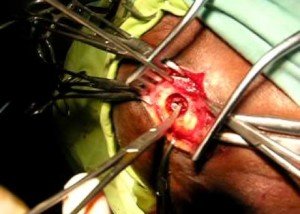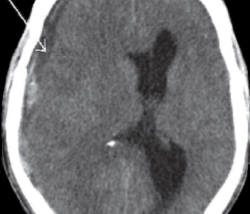
After a burr hole craniostomy for chronic subdural hematoma, a “drain” tube is left in the patient’s skull. This was the case of my mother.
She had a chronic subdural hematoma, and the drain tube that was placed in her head, after her second surgery, accidentally came out after she was shifting in her bed while propped up, and – according to her report – sat on the short tube, causing it to get tugged.
She immediately reported this to the staff via her nurse call button. If you clicked on this article, I needn’t explain to you what the burr hole drain looks like as it feeds into the patient’s head.
In the case of my mother, all that was there were small bandages, but the tube, as it entered the shaved portion of her head, was visible.
Will blood and cerebrospinal fluid spurt all over the place if the tube is pulled out (or comes out by accident, at least)? Not in the case of my mother.
I wouldn’t think any spurting would occur unless the burr hole tube came out the same day of the surgery.
In the case of my mother, it was tugged out on Friday; she had had the surgery two days prior on Wednesday. So by then, there wasn’t heavy draining.
I saw spots of a mixture of blood and cerebrospinal fluid here and there on the bed sheets, but nothing messy or alarming.
The burr hole is already draining in these cases, so if the tube comes out prematurely, of course the draining is going to continue.
But instead of the fluid draining into the tube, it will be “leaking” onto the scalp and will need someplace to go.
In this case, the fluid went onto the gauze that the nurse was sturdily applying to my mother’s scalp … after she paged the neurosurgeon for instructions.
Do not try to place the tube back in the burr hole! When the tube comes out, it immediately becomes contaminated! Instead, call the nurse if the patient already didn’t. Do not touch the hole.
When the nurse was applying compression, it was painful. Don’t panic if the nurse says that “brain juice” is coming out.
“Juice” means cerebrospinal fluid, possibly mixed with blood – which you already know is the objective of the draining in the first place when someone has chronic subdural hematoma.
You actually want this “juice” to continue to come out, because its collection in the brain is why the patient ended up having surgery in the first place.
As I watched the nurse maintain her compression on the burr hole, I asked how they were going to control the leaking.
She mentioned something about applying Vaseline which would create a barrier. Do we really want that, I asked, because the whole idea is to get the fluid out of the brain, not trap it in there with a barrier.
The nurse acknowledged my point, and then the neurosurgeon got back to her.
The final verdict was to wrap my mother’s head several times with a special wrapping, then have her lie on her side (the burr hole side against the pillow) as much as possible, so that gravity would allow continued draining.
A collection sheet was placed between her head and the pillow in case any fluid seeped through.
Why weren’t plans made to put in a new drain? This would require a sterile environment, i.e., another surgery in the OR, and also, the surgeon wasn’t available.
When my mother’s burr hole drain came out, it wasn’t an emergency situation. Again, the fluid is supposed to drain out anyways.
Next morning the bandages were removed and I was told that there had been minimal leaking, and the bandages remained off. Sutures were put in place.
 Lorra Garrick has been covering medical, fitness and cybersecurity topics for many years, having written thousands of articles for print magazines and websites, including as a ghostwriter. She’s also a former ACE-certified personal trainer.
Lorra Garrick has been covering medical, fitness and cybersecurity topics for many years, having written thousands of articles for print magazines and websites, including as a ghostwriter. She’s also a former ACE-certified personal trainer.
.









































